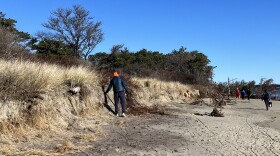Carissa Maurin has heard from people for a long time that blue mussels in Casco Bay had vanished.
"The mussel beds have been either disappearing or they haven't been able to find mussels where they usually have been able to find them for generations," said Maurin, the aquaculture program manager at Gulf of Maine Research Institute.
Some have linked the loss of a once-vibrant wild mussel population to an ocean heat wave in the Gulf of Maine about a decade ago. A 2016 study estimated blue mussel populations in the intertidal zone between high and low tides declined more than 60% in the last 40 years.

But what if the mussels didn't disappear entirely? What if they retreated to deeper, cooler water?
"We are still finding them in these subtidal or deeper water areas," Maurin said. "And these are locations that people wouldn't normally see unless you're there exactly at the right time, on the right date, within a two hour window."
Researchers are using acoustic surveys, volunteer observations and a marine drone to map out underwater mussel beds. Those findings will be compared to older maps to determine mussels' changing distribution, Maurin said.
"I think that's part of the problem, is that people are looking for them in these historic places, and they're no longer in those historic places," she added.
If there has been a massive loss of wild mussels, it could mean trouble for the broader ecosystem, said Aaron Whitman, another researcher at the institute.
Mussels are a keystone species that provides essential food and shelter for other species. As filter feeders, they can improve water quality, Whitman said.
"So if your ecosystem is doing well, you'll see mussels; if your ecosystem is not doing well, you might not see them," Whitman added.
No one is 100% certain what triggered the apparent decline of mussels in the intertidal zone.
Overfishing, predation and changing ocean chemistry could all play a role.
But a common theory is that skyrocketing water temperatures in the Gulf of Maine allowed invasive green crabs to colonize the state's shoreline. And without punishing winters to keep the crab population in check, they devoured everything in their path.
"Green crabs love mussels," said Brian Beal, a professor at the University of Maine at Machias.
"They're easily picked off. They don't have to burrow for them because they're, you know, they're sitting there on a rock or on some hard substrate," Beal added.
Maine's commercial landings fell by almost half in the last decade — from about 14 million pounds in 2012 to about 8 million pounds in 2024, according to Department of Marine Resources records. The colder waters of Downeast Maine may still support a wild population.
Meanwhile, mussel farmers have found it necessary to modify operations to stay viable.
For decades, Maine's mussel aquaculture could reliably grow shellfish simply by suspending ropes from offshore rafts and waiting for mussel larvae drifting by to land on them, Beal said.
"They put their ropes in the water and kind of pray to the zooplankton gods that mussels are going to settle on them. And for years and years and years and years, I guess their prayers were answered," he said.
Farms still rely on wild "seed" mussels, but the results are inconsistent now, Beal added.
"When you compare today's settlement on those ropes to just 10 years ago, it's almost night and day," he said.
Some farmers asked the Downeast Institute for help, by growing mussel larvae on ropes in a hatchery, then transferring that equipment to coastal aquaculture operations. For now, it's a backstop to ensure a reliable harvest, said Beal who is also the director of research at the institute. But demand is growing, to the point that a standalone mussel hatchery is being considered.
"There are farmers out there that are using the seed that's coming from the Downeast Institute Shellfish Hatchery, and we know that we could produce a lot more, and that the industry would accept more if we had more space," Beal said.
Bangs Island Mussels, in Portland, is one of the farms experimenting with hatchery larvae.
Owner Matthew Moretti said when he started Bangs Island with his father 15 years ago, wild seed from Casco Bay mussel beds provided reliable and consistent harvests.
But over time, the process became less predictable and sometimes his lines were overtaken by sea squirts and other organisms instead of baby mussels.
Now with 26 rafts that produce about 600,000 pounds of mussels a year, Moretti has invested in equipment to grow mussels on lines inside a Portland warehouse before moving them offshore.
His business still relies on wild mussel seed, but Moretti is looking forward to times when delivering a crop may depend on hatchery-grown mussels.
"We are working pretty hard towards a future where we could, if we needed, replace all of our wild mussel seed capture with hatchery seed instead," Moretti said.
It's also uncertain if his business is helping the local wild population by producing its own larvae, Moretti said. There's still a lot unknown about the state of Maine's mussels, he added.
"I think the ocean in general typically gets underestimated or taken advantage of," Moretti said. "It's almost like you assume that just goes on forever, just like all the wild fish stocks. It was easy to assume that they would never run out, but we know now that's not the case with mussels."





